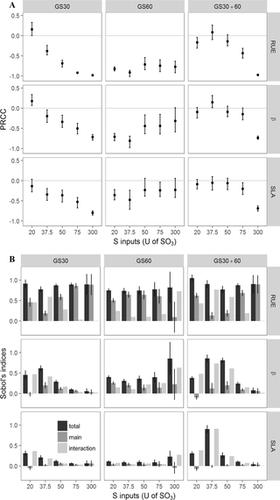PLOS ONE ( IF 2.9 ) Pub Date : 2018-09-20 , DOI: 10.1371/journal.pone.0204376 Emilie Poisson , Sophie Brunel-Muguet , François Kauffmann , Jacques Trouverie , Jean-Christophe Avice , Alain Mollier

|
Because sulfur (S) depletion in soil results in seed yield losses and grain quality degradation, especially in high S-demanding crops such as oilseed rape (Brassica napus L.), monitoring S fertilisation has become a central issue. Crop models can be efficient tools to conduct virtual experiments under different fertilisation management strategies. Using the process-based model SuMoToRI, we aimed to analyse the impact of different S fertilisation strategies coupled with the variablility observed in major plant characteristics in oilseed rape i.e. radiation use efficiency (RUE), carbon (C) allocation to the leaves (β) and specific leaf area (SLA) on plant performance-driven variables encompassing total biomass (TDW), S in the photosynthetic leaves (QSmobile.GL) and leaf area index (LAIGL). The contrasting S supply conditions differed in the amount of S (5 levels), and the timing of application (at bolting and/or at flowering, which included a fractioned condition). For this purpose, we performed a global sensitivity analysis (GSA) and calculated two sensitivity indices i.e. the Partial Raw Correlation Coefficient (PRCC) and the Sobol index. The results showed that whatever the timing of S supply, TDW, LAIGL and QSmobile.GL increased as S input increased. For a given S supply, there was no difference in TDW, LAIGL and QSmobile.GL between a single and a fractioned supply. Moreover, delaying the supply until flowering reduced the TDW and LAIGL whereas QSmobile.GL increased. Results showed that RUE had the greatest impact on TDW under all levels of S supply and all application timings, followed by β and SLA. RUE mostly impacted on QSmobile.GL, depending on S supply conditions, whereas it was the parameter with the least impact on LAIGL. Ultimately, our results provide strong evidence of optimised S fertilisation timings and plant characteristics that will guide producers in their agricultural practices by using specific varieties under constrained S fertilisation strategies.
中文翻译:

改善冬季油菜硫磺管理策略的敏感性分析
由于土壤中硫(S)的消耗会导致种子产量损失和谷物质量下降,尤其是在对含硫量高的作物(如油菜(甘蓝型油菜))中,尤其是对硫的监测已成为一个中心问题。作物模型可以成为在不同施肥管理策略下进行虚拟实验的有效工具。我们使用基于过程的模型SuMoToRI,旨在分析不同S施肥策略以及油菜油菜主要植物特性中观察到的变异性(即辐射利用效率(RUE),碳(C)分配给叶片(β))的影响。和特定叶面积(SLA)取决于植物性能驱动的变量,包括总生物量(TDW),光合叶片中的S(QS mobile.GL)和叶面积指数(LAI)GL)。相对的S供给条件在S的数量(5个级别)和施药时间(在抽ing和/或开花时,其中包括分馏条件)方面有所不同。为此,我们进行了全局敏感性分析(GSA)并计算了两个敏感性指数,即部分原始相关系数(PRCC)和Sobol指数。结果表明,无论S供应的时间是多少,TDW,LAI GL和QS mobile.GL都随着S输入的增加而增加。对于给定的S供应量,单个供应量和零碎供应量之间的TDW,LAI GL和QS mobile.GL没有差异。此外,将供应推迟到花期减少了TDW和LAI GL,而QS mobile.GL增加。结果表明,在所有水平的硫供应和所有施用时机下,RUE对TDW的影响最大,其次是β和SLA。根据S供应条件,RUE对QS mobile.GL影响最大,而对LAI GL影响最小。最终,我们的结果提供了优化的S施肥时机和植物特性的有力证据,这将通过在受限制的S施肥策略下使用特定品种来指导生产者进行农业实践。











































 京公网安备 11010802027423号
京公网安备 11010802027423号